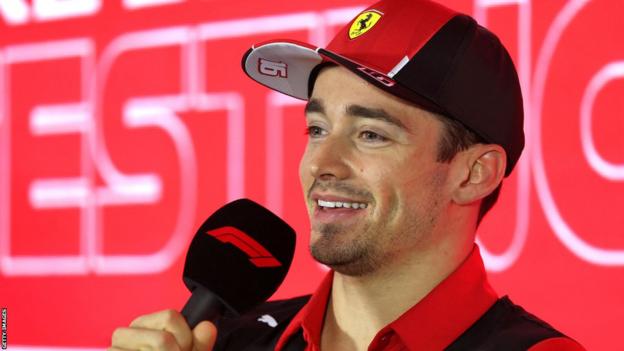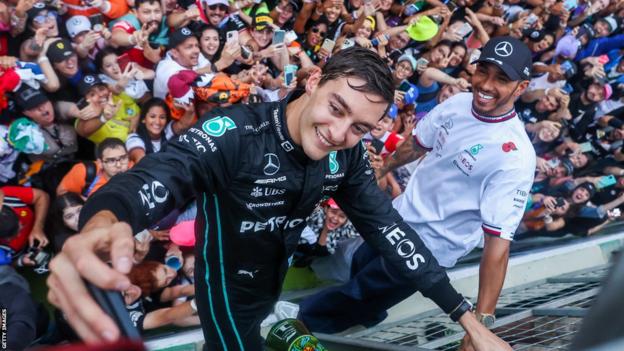

The 2023 Formula 1 season will be the longest in the sport’s history. The fear, as we draw closer to the opening race of the season in Bahrain this weekend, is that for many it will also feel like it.
Red Bull driver Max Verstappen starts the year as an overwhelming favourite for a third consecutive world title, and up and down the paddock there is serious doubt as to whether anyone can even make a fight of the season to come.
Verstappen heads into the year on the back of one of the most dominant campaigns in F1 history, in which his second world title arrived as he broke the record for wins in a season.
If Red Bull’s advantage is as big as it looks to be, and team-mate Sergio Perez remains unable to mount a consistent challenge to Verstappen, the concern for anyone interested in a close title fight is whether a challenge will materialise at all.
Red Bull finished pre-season testing last week positively oozing confidence. Normally, teams are reluctant to say much after testing, because the vagaries of fuel loads, engine modes, circuit conditions and so on make definitive judgements as to teams’ relative competitiveness difficult.
That remains the case, but it has been telling that the discussion in the paddock during and after the test has not been whether Red Bull have an advantage, but how big it is.
And Red Bull themselves were not even playing the usual games.
“Times, as we know in testing, are relative,” their motorsport adviser Helmut Marko told Sky Germany after the test.
“We don’t know what the competition was like on fuel, so if they were heavier than us, then our time is relative. But it has been shown that we are reliable, that we are fast, at the front.
“Above all that, what makes us very optimistic is that both of Perez’s and Max’s long runs were clearly at least faster than those of the competition.”
None of the above is an especially good advert for the new technical rules F1 introduced last season with the aim of making the racing closer and more competitive.
But amid the fears that 2023 will be a repeat of the utter domination achieved by Michael Schumacher and Ferrari in 2002 and 2004, or by Red Bull themselves with Sebastian Vettel in 2011 and 2013, the new rules do hold out one significant hope.
Among myriad changes all carefully planned to give the smaller teams a chance of catching up with the bigger ones was a sliding scale of restrictions on aerodynamic research, which are inversely proportional to a team’s success.
Under these rules, the leading team in the championship get the smallest amount of permitted aerodynamic research and the least successful the most.
This was never expected or intended to have an overnight effect, but in Red Bull’s case there is an extra factor to take into account.
Their punishment for being found guilty last year of breaching the sport’s new budget cap in 2021 was a further 10% reduction in aerodynamic research. That kicked in at the time of the penalty in late October, and lasts for a year.
The way F1 design processes work, that was not early enough to have a significant effect on the design of this year’s car in its initial form, which would have been laid down through last year. But it will affect Red Bull’s development of it, and work on their 2024 design.
The hope for rivals such as Ferrari and Mercedes is that even if Red Bull start the season with a significant advantage, as expected, this off-set in research allowance will give them a better chance of catching up.
Both of Red Bull’s main opponents head into the season amid uncertainty.
Ferrari are cautiously optimistic they can take the fight to the champions – or at least they say they are.
But even when they had a car every bit as fast as the Red Bull last year, they proved incapable of mounting a serious challenge. Race-strategy errors cost their lead driver Charles Leclerc three potential wins – in Monaco, Silverstone and Hungary. And engine failures accounted for two more – in Spain and Azerbaijan.
After that, Ferrari were forced to run their engines in a lower-power mode to avoid further failures.
Assiduous work over the winter has led to confidence that the reliability flaws, centred on the hybrid system, have been fixed, which will allow the engines to run in a more aggressive mode. That is said to give an immediate performance gain of 0.2secs a lap.
And Ferrari are confident they have improved their car, having paid particular attention to its weaknesses compared to the Red Bull last year, which largely centred on speed on the straight.
In testing, though, Leclerc said he was not sure whether reducing drag – which boosts top speed – had also had a negative effect on cornering performance. “It changed other characteristics,” he said, “all in line with what we expected, but we still need to find the right set-up for these characteristics.”

While Red Bull go into the new season as the very essence of stability – same drivers, same team, a refined and improved update of last year’s car – Ferrari have a new team principal, after chairman John Elkann tired of the errors under Mattia Binotto last year and lost confidence in him as the man to address them.
So far, the signs from his replacement Frederic Vasseur are good. The Frenchman arrived saying he recognised changes needed to be made, and has already made one big one – moving former head of strategy Inaki Rueda to a factory-based role and promoting one of his former lieutenants, Ravin Jain, to replace him.
“Fred arrived with very clear ideas and understands a team that’s very big,” Leclerc said. “Within a few days he understood what had to be done and he did it. It’s positive. His job is to put people in the right positions, and he’s excellent at it. Amazing.”
Before a wheel is turned in anger, Ferrari are the team who look likely to run Red Bull closest. Perhaps the biggest surprise of pre-season is there appears a genuine question mark over who will be next in line.
Mercedes ended last season on the up, having recovered from a dire opening sequence, worked diligently on their recalcitrant car, and taken a one-two in the penultimate race of the season in Brazil – George Russell ahead of Lewis Hamilton.
They were expected to make further strides in their campaign to return to the very front over the winter, but the jury remains out on whether they have.

Even before the car had run, team principal Toto Wolff used the word “eventually” to describe when he expected the car to be competing regularly for race wins.
“I was contemplating the word for 15 minutes when we did the press release,” Wolff said. “On one side you want to say: ‘We will be competitive.’ But on the other side you want to stay humble and so you say: ‘I hope at the midway point we will be competitive but we just don’t know when.’
“We are on the slope we wanted to be in terms of performance but you don’t know where the other ones are and humility is most important. We always try to be humble and we need to remind ourselves we were quite far off for a long time last season.”
The Mercedes car is something of an outlier in its aerodynamic design – the team having stuck largely with its ‘zero-sidepod’ philosophy from last year, very much against the trend of following Red Bull’s preference for wider bodywork with a dramatic undercut.
Mercedes say they believe their route can bring them success – although Wolff has conceded a new sidepod design is coming at a later point – but others have questioned whether they have stuck with it out of “engineering pride” and will pay the price.
Inside Mercedes, they believe they will start the season anywhere between 0.3secs and a second a lap behind the Red Bull, but that they should close in as the year progresses.
Hovering in the background at Mercedes, too, is the subject of Hamilton’s future. The British driver is out of contract at the end of the year. He says he “plans to stick around a while longer” and that the car’s competitiveness level will not be a factor in a decision Wolff has presented as an inevitability.
But the questions will keep coming until he puts pen to paper on a contract that will see him in F1 beyond 40, an age at which he said not that long ago he could not envisage himself staying in the sport.
A driver already into his fifth decade looks as if he might finally have a chance of a return to somewhere close to the front.
Fernando Alonso’s decision to move to Aston Martin for this season after Alpine prevaricated on a contract, refusing to give him the two years he wanted, was widely questioned last summer, as he was giving up a team heading for fourth place for one struggling towards the back of the midfield.
But the signs from pre-season are that the two-time champion has chosen wisely. Aston Martin have recruited heavily recently under ambitious owner Lawrence Stroll, and have a new technical team led by ex-Red Bull man Dan Fallows, with Eric Blandin, formerly of Mercedes, as his deputy.
Their new car turned heads last week. It was fast, and looked alive and responsive in the hands of Alonso, and many people said it looked like it was at least at the head of the midfield and might even give the Mercedes a run for its money.
The 41-year-old Spaniard last won a race in 2013, but his legendary status is secure, and he proved last year he has lost none of his skills and desire.
What a story it would be if the wily old legend was back somewhere close to the front, bringing the magnetism and drama that always seems to follow in his wake.
Other storylines to follow include the progress of Alonso’s former team, who replaced him with Pierre Gasly. That made it two French drivers in a French outfit, and two Gasly’s team-mate Esteban Ocon has said will “never be best friends”.
Then there are the apparent struggles at McLaren, who have admitted they have missed their development targets and will start the year on the back foot. And the progress of the Alfa Romeo-Sauber team under new boss Andreas Seidl, recruited from McLaren to lead their transformation into Audi by 2026, when perennial also-ran status will no longer be anywhere near good enough.
Off track, it has been a controversial winter, largely because of the antics of FIA president Mohammed Ben Sulayem.
Ben Sulayem upset the drivers with an apparent ban on freedom of speech – on which he has backtracked. And commercial rights holder F1 with an intervention on the value of the sport. And pretty much everyone else with the emergence of decades-old misogynistic comments.
Insiders are sceptical as to the motivation behind a move which was presented as part of a long-term plan, but which was perceived as very much a response to advice that he needed to back off for a while or risk being ousted, and it remains to be seen whether this new approach will last the length of the season.
There is, as ever in F1, plenty going on, both on and off the track. Which could be a good job this year, if the season develops in the way everyone interested in close competition fears. – bbc.com